17.1 General Description
17.2 Sahagún’s Signature
17.3 Valeriano’s Glyph and Name
17.4 Depictions of Juan Diego and the Apparition
17.5 Comparison with Early Guadalupan Engravings
17.6 Reconstructed Provenance of Codex
In 1995, while Juan Diego’s cause for canonization was being deliberated, the Jesuit scholar Xavier Escalada discovered a remarkable document painted on deerskin. The codex, which measures only 20 x 13 centimeters, was found by Escalada in a manila envelope inside a book, where it had been long forgotten in a private library in Querétaro. It depicts the Virgin of Guadalupe and Juan Diego on Tepeyac, and accompanying text mentions the apparition in 1531, the death of Juan Diego, and the year 1548. The codex bears the glyph of Antonio Valeriano, reputed author of the Nican mopohua or one of its variants, and is signed by Bernardino de Sahagún, the same Franciscan who had criticized the Guadalupe devotion as clandestine paganism. If authentic, the codex would solidify the historicity of basic facts of the traditional apparition narrative.
Naturally, such a fortunate amalgam of data in a single document seems too good to be true, and the document’s authenticity has come under heavy criticism on several points, which we shall examine in turn. We need not take an all-or-none approach to the document’s authenticity; there may be authentic elements mixed with later glosses, as is often the case with privately held antiquities.
The legitimacy of Juan Diego’s canonization does not depend on the authenticity of the Escalada codex. The Cuautitlán testament of 1559 and the testimonies of 1666 amply establish that Juan Diego was a real person, personally known by many in Cuautitlán, and that he was a man of exceptional character and a devout Christian. The Indians asked for his intercession in life and in death, and verified miracles have resulted from his intercession. The sainthood of Juan Diego does not depend on nor does it imply the historical accuracy of the apparition narrative of the Nican mopohua or the miraculous imprinting of the image on the tilma.
The codex is made of a cured deerskin, upon which is drawn a hilly landscape with individual flowers and plants growing from the ground, more or less evenly distributed. Toward the right is an image resembling Our Lady of Guadalupe, as her cloak appears to be speckled with stars. She is surrounded by an oval halo. At the far right, beneath the Virgin’s feet, is a depiction of a shrine or chapel, which may have been superimposed later. There also appears to be a sun rising over the horizon in the far upper right. In the upper left, in the distance, is depicted a small man in Indian garb. In the lower left is a larger depiction of a man kneeling, with much greater detail and ink that is more reddish than the rest of the drawing, which is in dark brown.
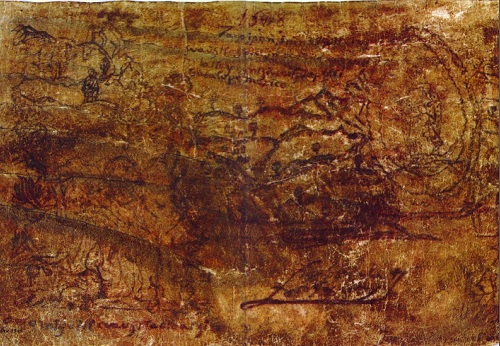
The codex contains several written elements that may or may not be of the same age as the picture. Most doubtful, at the top center, is the number “1548” with a possible hyphen between the 4 and 8, in lettering that is somewhat redder and lighter than other writing, which is in dark brown. Below this putative date are four lines of Nahuatl text that translate as follows:
Also in this year of 15031 there appeared to cuauhtlactoatzin our beloved mother (totlazonantzin) the Lady of Gadalope in Mexico.
Cuauhtlactoatzin is a diminutive form of Cuauhtlatoa, which was the Nahuatl name of Juan Diego, according to Sigüenza y Góngora. The year “15031” presumably is 1531; the irregular writing appears to have been of an indigenous person only moderately educated in Western letters.
In the bottom left of the codex, another line of Nahuatl reads: “Cuauhtlactoatzin died with dignity.” On the far right, toward the bottom, is a pictoglyph that is recognized as the signature of Antonio Valeriano. Beneath the glyph, a gloss reads “Juez Anton Vareliano.” Lastly, and perhaps most remarkable, is the signature of Fray Bernardino de Sahagún, in the lower right, though not as close to the border as Valeriano’s signature and its gloss.
This is a remarkable document with a complicated history, as indicated by the apparent insertion of later glosses. We must take care to distinguish the older parts of the codex from later additions. Physical studies by the Universidad Nacional Autónoma de México have concluded that the cured deerskin codex was indeed made in the sixteenth century, so it is probable that at least of some of the drawing or text dates back to that time.
One element that can be dated fairly accurately is the signature of Fray Bernardino de Sahagún. Critics complain that Sahagún, who wrote disparagingly of the Guadalupe cult, is unlikely to have endorsed such a document. Yet a signature does not necessarily signify endorsement. If the codex, for example, was in a church archive at some point, Sahagún might sign the document in order to register it. His signature in fact is found on many documents in church archives for this reason. Further, we have yet to determine how much of the image or text was on the deerskin at the time Sahagún signed it, so we cannot dismiss the possibility that he saw the codex without being scandalized by it.
Dr. Charles Dibble, an expert on the handwriting of Sahagún, examined the signature and found it to be authentic.
I have received a copy of codice 1548. I have studied the signature, and I believe it to be the signature of Fray Bernardino de Sahagún. I base my conclusions on the indications of three crosses; the form of the “Fray”, the “d” and the “b”. In my opinion the signature is not the same as, that is not contemporaneous with the 1548 date of the codice. I would assign the signature to the 50’s or the 60’s.
According to Dibble, Sahagún signed the document years after the death of Juan Diego. This does not necessarily mean the codex must be dated later than 1548, for Sahagún was not the author of the document, but an official who was authenticating or archiving it.
Although the signature was authenticated by Prof. Dibble and by handwriting experts at the Bank of Mexico, critics note that these examinations worked with photostatic copies, not the original codex. The possibility of a forgery in the nineteenth century or earlier cannot be completely ruled out, though there would be little reason for such a cunning hoax, given the total obscurity of the document.
At the extreme right of the codex is a picture of a shrine and the pictographic signature of Antonio Valeriano, both of which are crudely drawn, in comparison with the landscape. They appear to be later additions to the codex, and this is confirmed when we identify the origin of the Valeriano glyph and written name.
Beneath the Valeriano glyph, a gloss in Latin letters reads “Juez Anton Vareliano.” Now, it is hardly credible that the brilliant Valeriano would misspell his own name or draw his glyph so crudely. In fact, we find an identical misspelling accompanying Valeriano’s glyph in the Codex Aubin, the contents of which were drawn between 1576 and 1608, with older entries copied from earlier documents. The Valeriano material appears in the entry for 1573.

The glyph in the Codex Escalada is a clumsy imitation of the more accomplished artistry in the Codex Aubin, and the copying is given away by the exact repetition of the phrase “Juez anton vareliano,” complete with irregular spelling. In the Codex Aubin, these words are part of a sentence: “Anton Vareliano came as judge; he began his office today Sunday, the 18th day of the month of January.” The imitator instead used the word “juez” as though it were a title, so the Codex Escalada reads, “Judge Anton Vareliano.” Apparently, our unknown copyist was knowledgeable enough to associate Valeriano with the Guadalupan narrative, but not enough to spell his name correctly, or to know that his title was governor, not judge. The copying of Valeriano’s glyph need not have reflected an intent to deceive, but could have been motivated by a sincere, though mistaken, belief that Valeriano must have produced the 1548 codex.
The Codex Aubin was produced by Indians under the direction of a friar, possibly the Dominican Diego Durán. Its earliest known possessor was Lorenzo Boturini Benaducci, who enters it in his Catálogo del Museo histórico indiano (1742-45) as follows:
VIII, No. 14 Otra historia de la nación mexicana, parte en figuras y caracteres, y parte en prosa, de lengua náhuatl, escrita por un autor anónimo el año de 1576, del mismo modo, por otros autores indios hasta el año de 1608
In the late eighteenth century, Antonio de León y Gama made a copy of the entries through 1523. The original codex was then lost, and then acquired by M. Des Postes in 1880, until finally appearing at the British Museum, where it remains today.
The whereabouts of the Codex Aubin are unaccounted from its completion in 1608 to Boturini’s arrival in Mexico in 1736, and again from the death of Antonio de León y Gama in 1802 to the rediscovery of the codex in Europe in 1880. The Valeriano glyph in the Codex Escalada could have copied from the Codex Aubin during any of this time. Inserting the glyph before 1666 is unlikely, since until then none but Fernando de Alva Ixtlixóchitl and Luis Becerra Tanco knew of Valeriano’s supposed authorship of the Guadalupan narrative. An insertion of the glyph between 1802 and 1880 is also unlikely, since none but a few Guadalupan scholars were then interested in the origin of the Nican mopohua, and those few would have known to spell Valeriano correctly. This leaves the period from 1666 to 1736. Only friars and Indians then had access to these pictographic histories, and a friar would have been too literate to repeat the mistake of the 1576 codex. This means our copyist was likely an anonymous Indian of the late seventeenth or early eighteenth century.
It is misleading to characterize the copying of Valeriano’s glyph as a forgery, since the glyph is not supposed to be a personal signature or seal. It is simply the pictographic representation of his phonetic name. The Codex Aubin, in the customary style of Indian annals, uses pictographs to give basic information, which is then elaborated with text in Latin letters. The Codex Aubin is itself a copy of annals for events before 1576, and even the glyph in the original annal was not purported to be by the hand of Valeriano. Thus the glyph in the Codex Escalada should not be construed as an attempt to forge a signature in the Western sense. The copyist simply intended to convey the datum that Valeriano was the original source of the deerskin codex. He may have been mistaken in this attribution, but there was not necessarily an intent to deceive.
The presence of a later, copied element in the Codex Escalada need not imply that the entire document is inauthentic. Nonetheless, it gives us sound reason to examine the other elements of the picture and text with sharp scrutiny. We already have enough information, from the Sahagún signature and the Valeriano glyph, to see that the content of the codex was not produced all at once, but by parts in a period spanning more than a century.
There appear to be at least two levels of contribution to the document, apart from the pseudo-Valeriano addition and the signature of Fray Sahagún. First, the main landscape of craggy hills and simple flowers or shrubs, with the tiny figure in the upper left, and the image of the Virgin on the right, all share the same simple style and forceful dark lines. The Nahuatl text on top has similar features, and may be contemporaneous with the original image.
A second contribution seems to have been made in a more reddish ink, covering much of the lower left side of the codex. Here is a much more detailed and subtle artistic rendering of Juan Diego kneeling. The reddish tint of this drawing is the same as that of the text mentioning the death of Juan Diego at the bottom, as well as the number 1548 at the top. We know that 1548 was reputed to have been the year of the death of Juan Diego, so all of these elements relate to the death of the saint. Apparently, a later contributor added these commemoratives some time after the death of Juan Diego. If Fray Sahagún was ignorant of these contributions when he signed the document in the 1550s or 1560s, they must have been made afterward.
As mentioned previously, the picture of the shrine on the far right and the glyph of Antonio Valeriano are later insertions. It is possible that the crudely drawn rising sun in the upper right is also part of this late addition.
The various pictorial elements have striking similarity, even identity, with the earliest known engravings of the Guadalupan apparition, which date to the mid-seventeenth century. It remains to be determined, however, which document is the copy and which is more original in each instance.
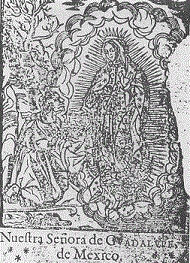 The foreground of the Codex Escalada appears to depict the third apparition, when Juan Diego gathered the flowers into his tilma. The earliest known depiction of this scene is an engraving found in the Novenas of P. Miguel Sánchez, printed in 1655.
The foreground of the Codex Escalada appears to depict the third apparition, when Juan Diego gathered the flowers into his tilma. The earliest known depiction of this scene is an engraving found in the Novenas of P. Miguel Sánchez, printed in 1655.
The points of similarity with the Escalada Codex are: Juan Diego is (1a) genuflecting, (1b) to the Virgin’s right, (1c) while holding out his tilma; and the Virgin is depicted (2a) as the Guadalupan Image, (2b) surrounded by an oval of clouds. These similarities are not strong enough to indicate dependence, however. Once it is granted that the Virgin shall be depicted as the Guadalupan Image (2a), it follows that Juan Diego must be positioned to her right (1b), the direction she faces. Genuflection (1a) was a common posture, appropriate to the religious scene, while the extension of the tilma (1c) is stipulated by the narrative of the third apparition. The depiction of heavenly personages as surrounded by clouds (2b) was common in artistic representations of the period.
There are also some significant differences. The engraving of 1655 has Juan Diego immediately adjacent to the Virgin, while in the Codex Escalada they are apart from each other. More strikingly, the 1655 engraving depicts Juan Diego with an authentic Indian hairstyle and clothing, while the figure in the Codex Escalada has Spanish features, including a pointed beard.
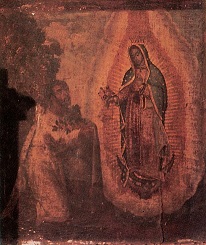 While there is not likely to be any direct dependence between the 1655 engraving the Codex Escalada, we may see the influence of the former in later paintings, such as Juan Correa’s depiction of the Third Apparition at the church of San Mateo Texcalyacac. Here we see the Virgin Mary and Juan Diego in similar postures, with the Blessed Virgin extending her hand over the flowers held by the Indian. The seer is depicted as bearded and swarthy, perhaps reflecting the artist's own mestizo heritage.
While there is not likely to be any direct dependence between the 1655 engraving the Codex Escalada, we may see the influence of the former in later paintings, such as Juan Correa’s depiction of the Third Apparition at the church of San Mateo Texcalyacac. Here we see the Virgin Mary and Juan Diego in similar postures, with the Blessed Virgin extending her hand over the flowers held by the Indian. The seer is depicted as bearded and swarthy, perhaps reflecting the artist's own mestizo heritage.
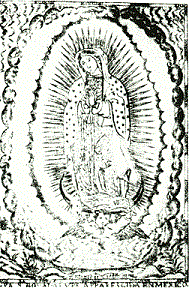 The depiction of the Blessed Virgin in the Codex Escalada bears some similarity to a 1666 engraving by Antonio de Castro, which illustrated Luis Becerra Tanco’s pamphlet Origen milagroso del Santuario de Nuestra Señora de Guadalupe (Mexico: Viuda de Bernardo Calderón, 1666). There is a basic similarity in drawing, with the surrounding clouds and the stars on the Virgin’s mantle. It is difficult to ascertain the closeness of the similarity, since the image on the Escalada codex is barely visible in many places. One notable difference is that the nimbus surrounding the Virgin has a pointed top in the Escalada codex, unlike the rounded oval in the Castro engraving. Various details in the figure, such as the sleeves, show that these are not exact copies, if they are copies at all.
The depiction of the Blessed Virgin in the Codex Escalada bears some similarity to a 1666 engraving by Antonio de Castro, which illustrated Luis Becerra Tanco’s pamphlet Origen milagroso del Santuario de Nuestra Señora de Guadalupe (Mexico: Viuda de Bernardo Calderón, 1666). There is a basic similarity in drawing, with the surrounding clouds and the stars on the Virgin’s mantle. It is difficult to ascertain the closeness of the similarity, since the image on the Escalada codex is barely visible in many places. One notable difference is that the nimbus surrounding the Virgin has a pointed top in the Escalada codex, unlike the rounded oval in the Castro engraving. Various details in the figure, such as the sleeves, show that these are not exact copies, if they are copies at all.
There is an unquestionable match between the left side of the Codex Escalada and a 1669 copper engraving (below, left), putatively attributed to Antonio de Castro, which illustrated the Poeticum Viridiarum by José López Avilés (Mexico: Viuda de Bernardo Calderón, 1669). The foreground image of Juan Diego is a perfect match when superimposed, as are the surrounding plants in the background. The 1669 engraving also has a match of the smaller image of man in Indian garb in the background.
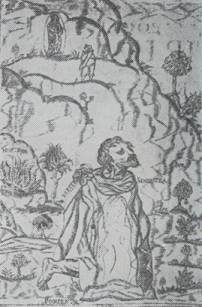

The engraving has further details that cannot be clearly discerned on the Escalada codex. Above and to the left of the Indian in the background is a small image of the Blessed Virgin. Evidently, two events are depicted simultaneously; the first apparition in the background and the third apparition in the foreground. In the engraving’s foreground image of Juan Diego, we can see the image of the Virgin being imprinted on the tilma. This is different from other depictions of the third apparition, which only show flowers over the tilma. It is a departure from Sánchez’s version of the narrative, which would have the imprinting take place before the bishop.
One of these drawings—the 1669 engraving or the Codex Escalada—was certainly copied from the other, but which is the direction of copying? From the standpoint of physical ease, it would have been straightforward to make the copper engraving from a tracing of the Codex Escalada image. All engravings were made from such tracings anyway. The reverse process, engraving onto leather, would also be possible, except the image on the deerskin is not engraved or tooled, but painted. Engraving would have been difficult anyway, since the leather itself would have been a hundred years old at that point, already too dry to be marked without cutting. Further, the indigenous method of leather engraving involved carving the image on a wooden instrument and then hammering it into the leather, so it was suitable for original images, not copying from a print. To copy an image onto leather with paint or ink would be technically formidable, if not impossible, since there is no way to trace onto leather without marking it.
As a further consideration, we note that the image on the left side of the Escalada codex appears to be a composite, made at two different times, possibly by two different artists. The background has the deep, dark angular lines and simple drawing style that characterizes most of the codex. The image of Juan Diego in the foreground, by contrast has softer, reddish lines, with a much more refined, detailed drawing style. Above and to the sides of the Indian, the codex is blank or washed out, as if some artist erased part of the landscape in order to superimpose his image of the seer.
If the image on the Codex Escalada is composite, then it is practically certain that the 1669 engraving was copied from the codex rather than the other way around. The engraving integrates the two images into a seamless unity, and adds an image of the Blessed Virgin in the background, which we do not find in the codex, in order to match up with the other Juan Diego. Thus the theme is changed to a simultaneous depiction of the first and third apparitions. The original codex (before the addition of Juan Diego in the foreground) would have depicted the first apparition only, as the figure in the background actually appears to be facing the Virgin on the right, since we see his hairline and the front of this dress, not the back. The engraving adds to the left side of the head a nose and eye, which are clearly absent from the codex. The engraver has evidently reversed the direction the Indian is facing.
The 1669 engraving date gives us an upper bound for the image of the codex. All of the main drawing, and likely its accompanying text, is to be dated no later than 1669. This rules out a late forgery, but does not enable us to date the codex more precisely. Evidently, the engraver Antonio de Castro had access to this codex, which is understandable if he did work for Luis Becerra Tanco’s pamphlet. Becerra Tanco claimed to possess various Indian antiquities, including a pictographic “map” recording the apparition of Guadalupe. He also mentions that historical events were painted on animal skins, and that these documents were not made by the ignorant commoners, but only by their priest-historians.
The Escalada codex was not used for the engraving on Becerra Tanco's 1666 pamphlet, but this is unsurprising, since Becerra Tanco attested at this time that many of his notes and ancient documents had been lost. These were recovered some time before his death in 1672, as he relates in the prologue to the second edition, titled Felicidad de México. Published posthumously in 1675, the Felicidad includes an engraving that clearly imitates the pictorial layout of the Escalada codex as a whole, though re-drawn in an original style with distinct embellishments. Some have attributed the 1675 engraving to Antonio de Castro, but I find this does not match the artistic style of his other works.
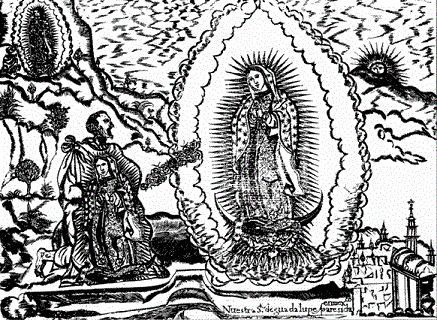
This engraving is sometimes called “El [grabado] Sevillano,” since it was discovered in the 1685 Seville reprinting of Felicidad de México, but it was also in the 1675 Mexico City printing (Viuda de Calderón), so it is clearly Mexican in origin. We note several new features: (1) the Virgin in the background is much larger than in the 1669 engraving, and Juan Diego has been moved to her right (our left); (2) the image on the tilma is now identical to that of Our Lady of Guadalupe; (3) smoke or rays emanate from the Virgin to the tilma, representing the means of miraculous imprinting; (4) the nimbus surrounding the Virgin is pointed at the top, unlike the 1669 engraving but matching the Codex Escalada; (5) a rising sun, temple and other buildings are on the extreme right, much like the seemingly late additions to the codex.
The anonymous engraver of 1675 evidently had access to Castro's 1669 engraving and the Codex Escalada. The newer engraving lacks the artistic subtlety of Castro’s work and of the foreground depiction of Juan Diego in the codex, but it is markedly superior in technique to the rest of the codex painting. The various elements of the 1675 engraving are well spaced and proportioned to emphasize the third apparition. The background depiction of the first apparition, however, is practically a repetition of the foreground image, and would be artistically pointless unless the engraver felt some obligation or deference toward his source material. Note that the 1675 engraver repeats the mistake of the 1669 engraving, by making the hill contour extend all the way up, above the Virgin of the first apparition. In the codex, instead, the hilltop is just above where the Indian is standing.
The hypothesis that the Codex Escalada is a copy of the 1675 engraving is implausible, since the image on the codex is a composite of at least three distinct contributions: (1) the main landscape and first apparition; (2) the foreground image of Juan Diego; and (3) the temple and rising sun on the extreme right. It is hardly credible that three distinct contributors should independently copy parts of the engraving piecemeal, and we have already shown that the codex antedates even the 1669 engraving. It remains for us to synthesize the evidence into a plausible history of the contributions to the codex image.
We discern three phases of contribution to the drawing and text on the Escalada codex. First, the main image was drawn, including the landscape, the Indian in the background, and the Virgin on the right, along with the lines of Nahuatl text at top. This was completed no later than 1570, when Fray Sahagún affixed his signature. The foreground image of Juan Diego, along with the line of text beneath it, and the reddish “1548” atop the codex, was a later addition, made some time after Sahagún’s signature, yet before the engraving of 1669. Lastly, someone added Valeriano’s glyph and name to the extreme right, also squeezing in a crude drawing of a shrine or church, and possibly a rising sun. Since the latter elements likely originated with the 1675 engraving, this last contribution was made sometime between 1675 and Boturini’s acquisition of the Codex Aubin c. 1736. This composite history is depicted below.


We can now reconstruct the likely provenance of the codex. In the 1550s or 1560s, an indigenous artist painted the main image [outlined in red] of a barren landscape dotted with magueyes, nopales, and a small tree. The painting records the apparition of Our Lady on Tepeyac, with a simple Indian man beholding her from a distance. The four lines of writing are likely by the same artist, as they are similarly irregular and of the same ink tone. Again, they read:
Also in this year of 15031 there appeared to cuauhtlactoatzin our beloved mother (totlazonantzin) the Lady of Gadalope in Mexico.
This text was apparently copied from an annal, as one of several entries for that year. Our artist was probably of the priestly caste, as only they were entrusted with historical annals, and with the making of pictographic records such as this codex. Also, at this early date, Indians could learn Latin letters only at the school of Tlatelolco, which recruited boys from the aristocratic and priestly castes.
The codex is the earliest witness to the 1531 date of the apparition. We know from other sources that the apparition was known as “Guadalupe” as early as 1555, and the indigenous writer renders this as “Gadalope.” We also find an early mention of Juan Diego by his indigenous name, Cuauhtlactoatzin. The testament of 1559 shows that Juan Diego was already well known as the seer of Guadalupe, at least in the vicinity of Cuautitlán.
When Fray Bernardino de Sahagún put his signature on this codex, there was nothing in its content that he would find objectionable. The codex only mentioned the appearance of Our Lady at Tepeyac, and said nothing about a miraculous image on a tilma. Sahagún, it will be recalled, was no enemy of Marian devotion, but objected only to the idolatrous treatment of painted icons. The codex before him contained no such objectionable material, so he had no qualms about signing it. After the 1550s, all indigenous religious art had to be inspected in order to be sure there were no pagan elements. Fray Sahagún’s signature may have certified the work of this indigenous artist as free from idolatry.
Another possibility, mentioned previously, is that Fray Sahagún signed the codex to register it in an archive. We know that he gathered many Indian manuscripts for his histories. Although he was a firm opponent of anything that smacked of idolatry, he took great care to preserve records of pre-Hispanic pagan customs. Thus, even if Sahagún thought the codex to be idolatrous, he might still have signed and possessed the codex for archival purposes.
In the late sixteenth or early seventeenth century, a superior artist, familiar with the story of the tilma, drew a more detailed foreground picture [outlined in orange] of Juan Diego extending his tilma to receive the image. The detailed vegetation to the left might also be the work of the second artist. Accompanying his contribution is a line of text saying, “Cuauhtlactoatzin died with dignity.” Evidently, the second artist wished to commemorate the death of Juan Diego, so he is likely responsible for adding the 1548 date to the top, using similar reddish ink.
The second artist uses a more Castilian painting style, and he makes Juan Diego bearded and Spanish looking, though he is familiar with Nahuatl. This may have been a mestizo artist, for we have seen how the mestizo Juan Correa depicted the seer with swarthy Spanish features. The artist was familiar with the story of Juan Diego, which we have already seen was widely known by the early seventeenth century. His access to the codex is best explained if it was not in an ecclesiastical archive at this point in time, which might better account for how Luis Becerra Tanco came to possess it along with other Indian antiquities.
Note that this artistic depiction of the miraculous imprinting on Tepeyac differs from the accounts of Sánchez and Lasso de la Vega, which do not mention the miraculous image until Juan Diego’s arrival at the bishop’s palace. Evidently, the artist was not dependent on these accounts. It is possible that he wished only to depict the miraculous image on the tilma, without intending to assert that the imprinting took place on the mount.
This modified codex (or a copy of it) reappeared in the 1660’s, and was used for engravings in at least two publications—the Poeticum viridiarum by José López Avilés (1669) and Felicidad de México by Luis Becerra Tanco (1675)—and possibly a third, Becerra Tanco’s 1666 pamphlet, Origen milagroso…. The most likely owner of the codex would have been Becerra Tanco, a known collector of Indian antiquities. Its appearance in Avilés’ work may be accounted by the fact that the same engraver, Antonio de Castro, was employed, as was the same publisher, the widow of Bernardo Calderón. Alternatively, Avilés, an erudite scholar in his own right, might have acquired the codex. We know he was familiar with Francisco de Siles and with Francisco de Florencia, each of whom wrote letters of approbation in his works Poeticum viridiarum and Debido recuerdo de agradecimiento leal (1684), respectively. Carlos Sigüenza y Góngora, another possessor of indigenous antiquities, praised Avilés as a Virgil of the New World, but it is uncertain if he knew the poet personally.
The engraver of the 1669 illustration treated the codex as if it were a single work, representing the first and third apparitions simultaneously. A second image of the Virgin Mary was added to the upper left background of the engraving, and the background Indian was altered so that he faced backward to his left. The engraver of 1675 did not use a tracing of the codex, but composed the image by his own hand, adding embellishments such as the depiction of a church and city in the lower right, and a rising sun on the upper right (if this was not in the codex already).
Lastly, in the late seventeenth or early eighteenth century, some anonymous contributor added the glyph and misspelled name of Antonio Valeriano, as well as a crude picture of a shrine or church, and possibly the rising sun. This person must have had access to the Codex Aubin and a copy of Felicidad de México. He must have known something of the belief that Antonio Valeriano was the author of the Guadalupan narrative, yet was sufficiently ignorant not to correct the misspelled name. This excludes Becerra Tanco and any comparable scholar. Possibly the culprit was a church archivist or a moderately educated Indian.
The motive for this insertion was unlikely to be forgery, for the codex already bore Sahagún’s signature, which sufficed for its authentication. The person who drew the glyph probably truly believed that Valeriano was the source of the codex, as the theory of Valeriano’s authorship of the Guadalupan narrative was fairly well circulated among Guadalupan writers, thanks to Florencia’s work. This identification was undoubtedly mistaken, as Valeriano was too excellent a student to be responsible for the crude writing on the original codex.
The codex was likely rediscovered by Lorenzo Benaducci Boturini, as most extant Guadalupan antiquities passed through his hands at some point. He possibly refers to the codex when he writes:
Tengo el Retrato original de exquisito pincel del mismo Juan Diego, puesto de rodillas à el lado del Pozo de Guadalupe y mirando à la cumbre del Cerro Tepeyècac, donde se le apareció la Gran Señora…
I have the original Portrait with exquisite brushwork of Juan Diego himself, kneeling beside the Well of Guadalupe and looking to the peak of the Hill Tepeyècac, where the Great Lady appeared to him… [Boturini, Idea de una nueva historia general de la América septentrional (1746), p. 158.]
After the confiscation of the Boturini collection in 1743, many of the documents were gradually dispersed among private collectors and institutional archives, as discussed previously in the context of Sigüenza’s lost manuscripts. The deerskin codex was finally recovered from obscurity in a private library in Querétaro by P. Xavier Escalada in 1992. Donor confidentiality prevented him from revealing more about the provenance of the document, but hopefully, in time, we will be able to reconstruct its more recent history, validating or correcting the outline above.
While the Escalada codex is not quite the Holy Grail of Guadalupan studies that it is sometimes made out to be, it does provide important evidence of mid-sixteenth century belief in a Guadalupan apparition to an Indian named Cuauhtlactoatzin. It is the oldest extant document attesting to the traditional 1531 date of the apparition, not counting annals whose entries cannot be definitively dated. The later text and painting commemorating the death of Juan Diego, including the number “1548,” cannot be dated with any accuracy. We cannot invoke the codex, then, as early evidence of belief in a miraculous imprinting on the Indian’s tilma.
Having completed our discussion of the available historiographical evidence about the Guadalupan narrative, we will turn to one last witness: the Image itself.
© 2013 Daniel J. Castellano. All rights reserved. http://www.arcaneknowledge.org
| Home | Top | Comment |